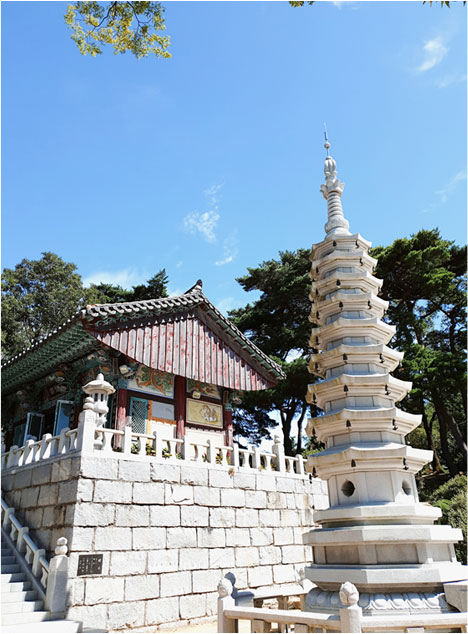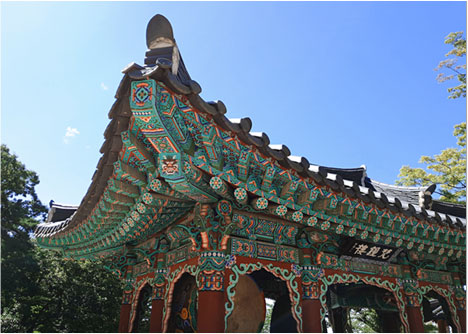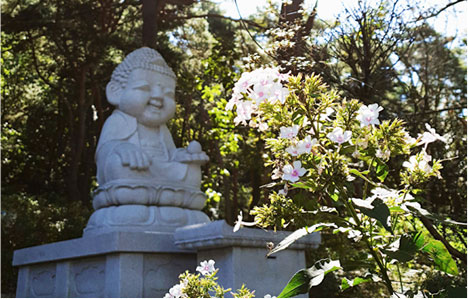Hoamsan Mountain Course Review
- home
- Culture & Tourism
- Tour of Geumcheon
- Hoamsan Mountain Course Review
Hoamsan Mountain Course Review
I recommend you to set out your journey towards the <History and Culture Trail of Hoamsan Mountain>
where you will be able to fully enjoy and experience the legends and history to
fill your heart and improve your health with as many steps as you take.
“Again, the building has collapsed...”
ing Taejo, born Yi Seong-gye, attempted to build a palace in Hanyang (Seoul) for the newly founded Joseon, but the palace kept
on collapsing for unknown reason.
Master craftsmen from all over the country gathered to find its cause but their efforts proved in vain.
Then one night, a mysterious creature that resembled half-tiger and half-unknown appeared from the depth of the darkness.
Guards of King Taejo kept on firing arrows at it but no matter how many arrows struck its body, the creature still knocked down the palace and vanished into the darkness.
As King Taejo returned to his bedroom in dismay, he moaned.
“Perhaps, Hanyang is not the right place for me to set up the capital..”
Just then, he heard the voice of an old man coming from outside.
"Hanyang is a perfect place to build a capital.”
Taken aback, King Taejo went outside and found an old man with a gray beard standing under the moonlight.
The old man pointed at the peak of a mountain south of the Hangang River.
The peak of the mountain, which resembled the head of a tiger that tore down the palace, was overlooking Hanyang.
“The tiger's weakest point is its tail, so if you build a temple at th e tail part of the mountaintop, everything will go as planned.”
Soon, King Taejo began to build a temple at the tail part of the mountaintop, and named it as Hoapsa Temple.
Come visit the <History and Culture Trail of Hoamsan Mountain> where such fascinating legends and history are alive and well.
You can take Maeul bus Geumcheon 01 and get off at ‘Hoapsa
Temple Entrance’ stop, or you could choose to walk here from
‘Geumcheon-gu Office’ to warm up your body. If you choose to
walk up the road, it will take you around 50 minutes to walk
3km across Siheung-dong. The air here feels so fresh that you
may forget for a moment that you are still in Seoul, thanks to
Hoamsan Mountain.
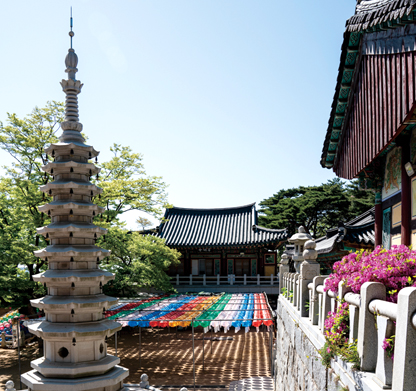
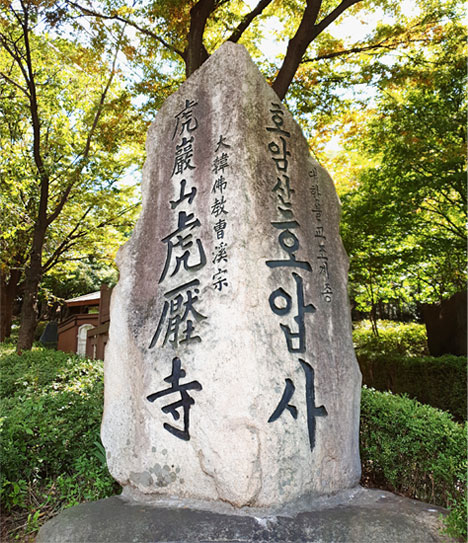
As I continue to follow the trail surrounded by fresh air, a thin sheen of sweat begins to glisten on my forehead along with the gradual rise in elevation.
leads to the tail of a tiger. On this road, I wondered for a moment about our ancestors who once
climbed the mountain to suppress the energy of the tiger.
red squirrels that keep running from place to
place as if the steep rises and falls are not there
to challenge them.
The sight of incredibly swift and fast squirrels
somewhat makes my dragging feet show more ani
mation. As I walk up the trail, a chant of Buddhist
scriptures slowly reaches my ears. I look up to where
the sound is coming from, and ‘Hoapsa Temple’
begins to slowly reveal itself.
Hoapsa Temple was built to suppress the tiger-like
creature that had hindered Hanyang from becoming a capital.
Perhaps because of my knowledge in the myth, I deeply feel its splendor and majesty, unrivaled by no other temples.
Many hikers, along with Buddhists, are resting their legs in a vacant lot located nearby.
The next destination is Ggalddak Gogae Hill leading to the peak of Hoamsan Mountain, so I should get enough rest here in this lot.
As I now feel well recovered, I turn my steps towards the direction marked on the sign that reads <Hanumul Well>.
The hikers start to breathe heavily, matching the sound of trees hit by the wind. Although this is a tough spot to climb, it is the last uphill trail on the <History and Culture Trail of Hoamsan Mountain> and the scenery and breeze at the peak will make your efforts worthwhile, so let's pull ourselves together just a bit longer.
Crossroads frequently appear on Hoamsan Mountain. If you are unsure which path to take, pause for a moment and ask other hikers around you for directions. Unfounded conviction may result in an unexpected journey.
the refreshing wind and the panoramic view of
Seoul welcome you with open arms.
The spectacular view and refreshing wind richly repay you for your efforts made in reaching
the top. As I gaze upon the buildings of Seoul, densely populated like trees in a forest, many
thoughts run through my mind. All my worries and woes that I carried on my shoulders while
in the city now feel behind me at the top of the mountain.
Perhaps, <Hoamsan Mountain Fortress> was built here to capture the view of Seoul. <Hoamsan Mountain Fortress> was built during the Unified Silla Period, with the peak-banding architectural technique of encircling the mountaintop. The remains are visible for about 300m out of the total circumference of 1,547m.
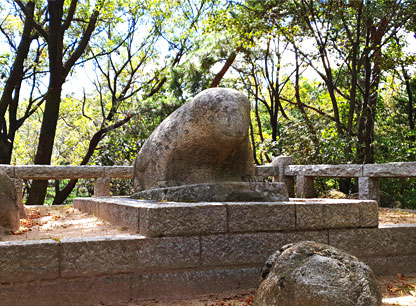
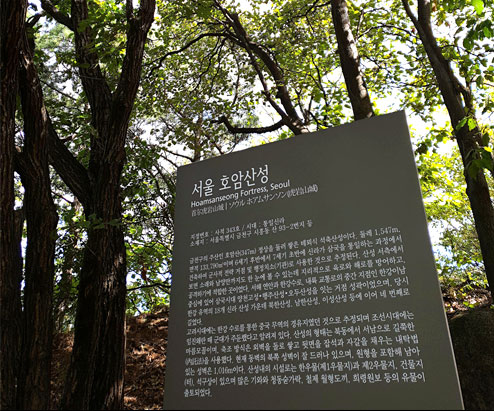
Many crossroads also emerge at the top as well, and it would be better to ask other hikers around you for clear directions to <Hanumul Well>. One thing to keep in mind is that both ‘Chanumul Well’ and ‘Hanumul Well’ are located nearby the mountaintop. If someone mishears you and tells you the direction to ‘Chanumul Well,’ you will be set out on an unexpected journey, so make sure to pay attention. ‘Chanumul Well is a small mineral spring, while ‘Hanumul Well’ that we are now headed to is a large well next to ‘Bulyeongam Temple.’
By the time we reach <Hanumul Well> over the ridges and rocks, <Seokgusang> finally appears to greet us. Two kinds of energies prevented Hanyang from becoming a capital, and one of the two was the previously mentioned energy of the tiger at Hoamsan Mountain, and the other is the energy of fire emanating from Gwanaksan Mountain. If <Hoapsa Temple> had suppressed the energy of the tiger, it was <Seokgusang> that subdued the energy of fire. Also, it is fascinating that Seokgusang is built to face Haetae of Gyeongbokgung Palace to prevent fires in Seoul together in tandem.
-
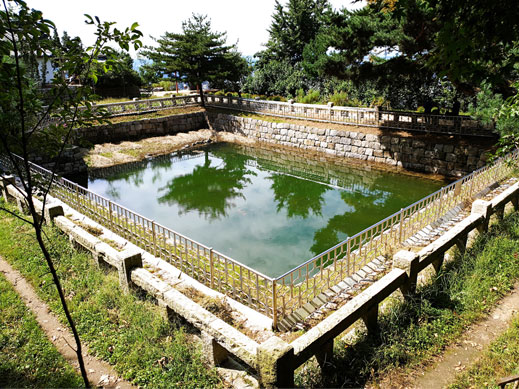 <Hanumul Well> is located nearby
<Hanumul Well> is located nearbyHanumul Well, which served as a place to hold
rituals for rain during droughts as well as a
water source for troops in wartime, contains a
constant amount of clear and fresh water
throughout the years despite its location at the
mountaintop. The sky reflected in the clear
water of Hanumul Well makes you pause for a
second in awe of its serenity and tranquility. -
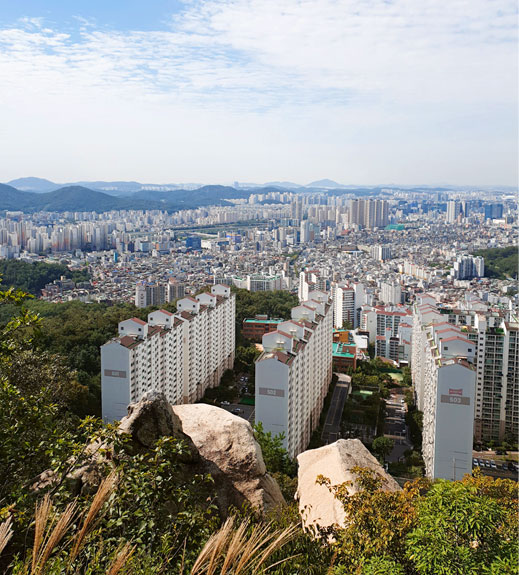
As you walk down the downhill path stretched
out for about 15 minutes, the view of Seoul
appears, resembling the shape of a sword laying
on its side. With the sight of ‘Hoapsa Temple’
and ‘Seokgusang’ that repress the energies of
the tiger and fire still lingering in my mind, it
feels as if the sword-like rock is also reliably
protecting Seoul.
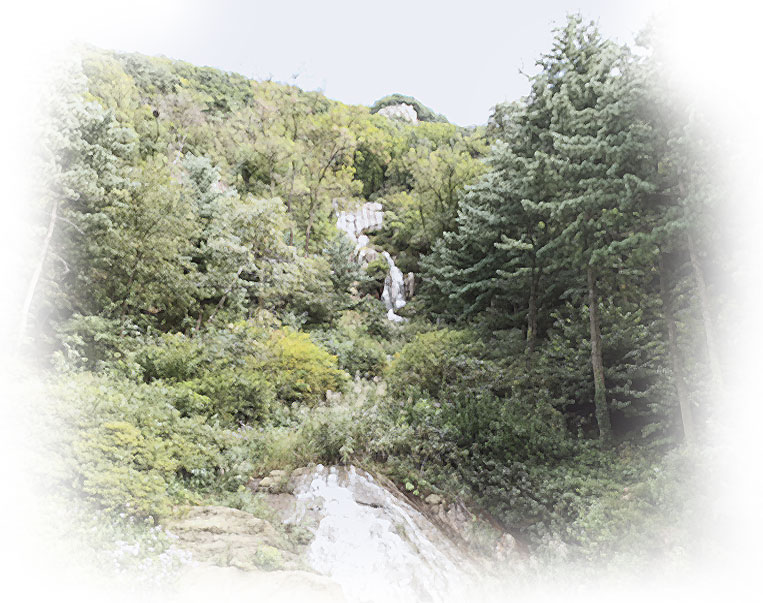
The sight of the waterfall emptying itself right into
the stream clears my mind. An interesting fact
about this waterfall is that it is man-made. The
clever idea of creating a waterfall by drawing water
out of a closed mineral spring through natural rock
exposed by landslides is truly admiring. As the
waterfall shatters its magical water three times a
day, from 9:00 to 9:30, 12:00 to 12:30 and 15:00 to
15:30, it would be a good idea to walk this course
during these hours.
you will see the entrance to an underground passage. There stands <Hocheon
Mineral Spring>, which was ranked third in the ‘list of healthy mineral springs,’
before the entrance. As its water boasts high contents of potassium and
minerals, I should cap my journey here with a full glass of water.
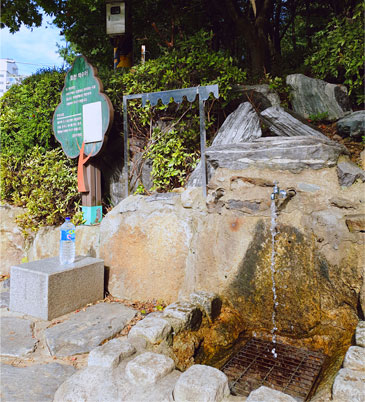
I recommend you to set out your journey towards the <History and Culture
Trail of Hoamsan Mountain> where you will be able to fully enjoy and experi
ence the legends and history to fill your heart and improve your health with
as many steps as you take.

